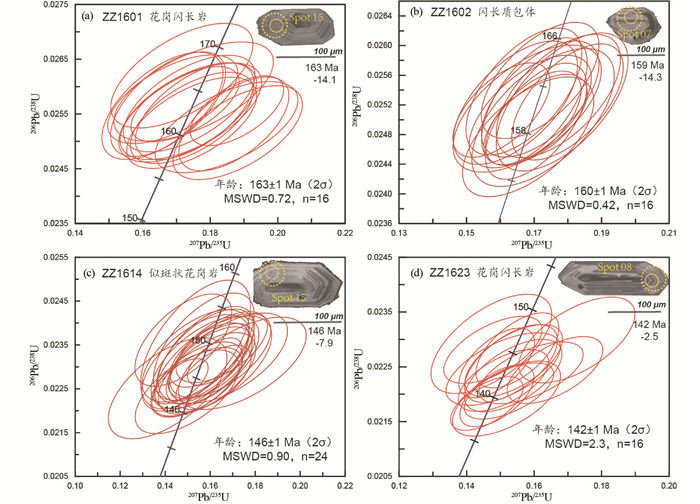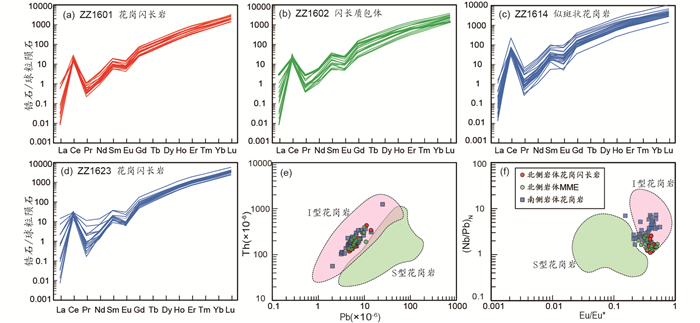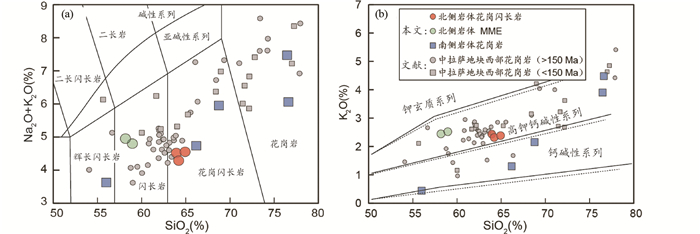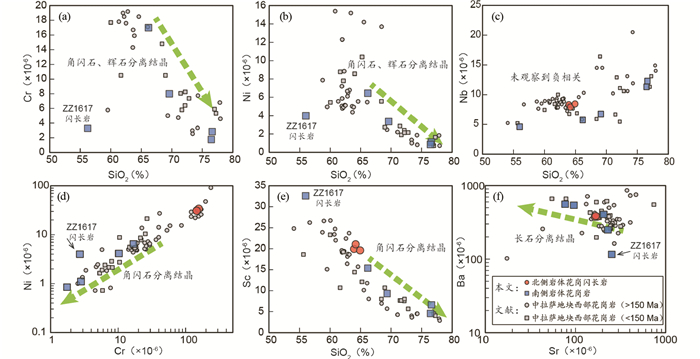位于青藏高原南部的拉萨地块被认为是从冈瓦纳大陆分离出来的构造块体,它向北漂移并与羌塘地体的碰撞导致了班公湖-怒江洋在白垩纪早期的闭合(Dewey et al., 1988; Zhang et al., 2004; Kapp et al., 2005, 2007; Zhu et al., 2011a, 2013, 2016),拉萨地块作为亚洲大陆的最南缘,与向北漂移的印度大陆发生碰撞,导致新特提斯洋在新生代早期闭合(莫宣学等, 2003; Mo et al., 2007, 2008; Ji et al., 2009)。在拉萨与羌塘地块碰撞、印度与欧亚大陆碰撞,以及班公湖-怒江洋和新特提斯洋的俯冲消减等一系列地质过程中,形成了现今暴露在青藏高原上的大量的中生代和新生代岩浆作用记录。
近年来对中部和北部拉萨地块中生代岩浆作用,已有一些研究结果,对于班怒洋的发育过程、洋壳俯冲与关闭等演化过程提出了一些模型(黄俊平等, 2006; Zhu et al., 2009a, 2011a, 2016; 姜昕等, 2010; 刘敏等, 2011; 李小波等, 2015; Cao et al., 2016; 闫晶晶等, 2017; Wang et al., 2018)。一般认为,晚侏罗世以来,班怒洋发生了向南和向北的双向大洋岩石圈俯冲作用,之后发生了班怒洋的关闭和拉萨与羌塘地块的对接,在大约113Ma发生了大规模的岩浆作用,代表了板片断离过程(Zhu et al., 2009a)。以岩浆作用为主要线索揭示的上述演化过程依然存在不少争议,急需补充新的证据。本文选择出露于中拉萨地块西部噶尔县左左乡东侧和东南侧的两个晚侏罗世-早白垩世中酸性侵入岩岩体,开展了详细的锆石U-Pb年代学、微量元素和Hf同位素以及全岩地球化学研究,结合前人资料,探讨了左左乡岩体的成因与演化,试图对研究区晚侏罗世-早白垩世构造-岩浆作用过程提供新的证据。
1 地质背景与样品青藏高原自北向南分别由松潘-甘孜复理石杂岩带、羌塘、拉萨地块和喜马拉雅带组成(图 1)。这些地体分别被金沙江缝合带(JSSZ)、班公湖怒江缝合带(BNSZ)和印度河-雅鲁藏布缝合带(IYZSZ)所分隔。其中拉萨地块又以狮泉河-纳木错蛇绿混杂岩带(SNMZ)和洛巴堆-米拉山断裂带为界,进一步划分为北部拉萨地块(NL)、中部拉萨地块(CL)和南部拉萨地块(SL)三个次级地体,其中中部拉萨地块具有古元古代甚至是太古代结晶基底(Zhu et al., 2009a, 2011b, 2013)。分布于中部及北部拉萨地块的除了大量的白垩纪岩浆岩外(Zhu et al., 2009a),也有近年来中部拉萨地块中西段的一些晚侏罗世岩浆岩报道(Cao et al., 2016; 闫晶晶等, 2017; Wang et al., 2018)。

|
图 1 青藏高原构造单元图及研究区地质简图 (a)青藏高原构造单元划分图(据朱弟成等, 2008);(b)西部拉萨地块中生代岩浆活动分布简图(据Zhu et al., 2009a);(c)研究区地质简图(据许荣科等, 2014修改) Fig. 1 Tectonic subdivision of the Tibetan Plateau and geological map of the study area (a) tectonic subdivision of the Tibetan Plateau (after Zhu et al., 2008); (b) simplified Mesozoic-Cenozoic magmatic activity distribution of Lhasa Terrane (after Zhu et al., 2009a); (c) geological map of the studied area (modified after Xu et al., 2014) |
本文研究区位于中拉萨地块西段噶尔县左左乡附近,分别位于左左乡通往革吉县城的301省道北侧和左左乡东南冲沟内约10km,岩体出露面积分别约为30km2和70km2。研究区距北部班公湖-怒江缝合带约100km。两岩体岩性主要为花岗闪长岩、二长花岗岩、似斑状花岗岩等,北侧岩体发育有大量的闪长质包体(图 2a),包体呈大小不一的椭圆状到不规则状,包体中可见钾长石巨晶(图 2a),镜下可见针状磷灰石(图 2c);南侧岩体主要为花岗岩和闪长岩。本文研究的样品情况见表 1。

|
图 2
左左乡岩体样品野外(a)及显微(b-f)照片
Q-石英;Pl-斜长石;Kf-钾长石;Hb-角闪石;Ap-磷灰石;Bt-黑云母
Fig. 2
Field outcrop image (a) and micrographs (b-f) of the Zuozuo batholith samples
(a) ZZ1607, ZZ1608 samples field photos; (b) ZZ1607, Granodiorite; (c) ZZ1608, Diorite enclaves; (d) ZZ1614, Porphyritic granite; (e) ZZ1617, Diorite enclaves; (f) ZZ1623, Granodiorite Q-quartz; Pl-plagioclase; Kf-K-feldspar; Hb-hornblende; Ap-apatite; Bt-biotite |
|
|
表 1 左左乡岩体样品采样位置及岩石类型汇总表 Table 1 Sampling position and petrographic characteristics summary of Zuozuo batholith |
野外采集的样品在河北省廊坊市区域地质矿产调查研究所完成探针片磨制、200目粉末制备、挑选单矿物等样品处理工作。全岩主量元素分析在中国地质大学(北京)地质过程与矿产资源国家重点实验室完成,采用Prodigy型全谱直读等离子体发射光谱仪(ICP-OES)测定,分析精度优于10%。全岩微量元素分析实验在武汉上谱分析科技有限责任公司分析测试中心使用电感耦合等离子体质谱(ICP-MS,Agilent7700)完成,分析精度优于10%。具体实验流程及原理见Liu et al. (2008)。
2.2 锆石U-Pb年代学和Hf同位素锆石U-Pb定年和微量元素测试在中国地质大学(北京)矿物激光微区分析实验室(MILMA, Mineral Laser Microprobe Analysis Laboratory)应用LA-ICP-MS测定。实验中,采用Wave 193UC型ArF准分子激光器进行剥蚀取样,Agilent 7900四级杆型等离子质谱仪测试离子信号强度。实验过程中采用NIST 610作为元素含量外标,锆石91500(Wiedenbeck et al., 2004)作为U-Pb同位素比值外标,锆石GJ-1(Jackson et al., 2004)和Plesovice(Sláma et al., 2008)作为未知样品的数据质量监控标样来进行分析。
锆石Hf同位素分析在中国科学院地质与地球物理研究所多接收等离子质谱仪实验室,利用配备有Geolas-193型紫外激光剥蚀系统(LA)的Neptune型多接收电感耦合等离子体质谱仪(MC-ICP-MS)完成。样品分析时激光剥蚀的时间为26s,激光剥蚀脉冲功率为100mJ时的脉冲频率是10Hz,束斑直径大小约为60μm。详细的测试流程和数据校正方法见Wu et al. (2006)。
3 结果 3.1 锆石U-Pb年代学、微量元素和Hf同位素 3.1.1 北侧晚侏罗世岩体本文对北侧晚侏罗世岩体的1件寄主花岗闪长岩和1件闪长质包体样品进行了锆石U-Pb定年(表 2)。年龄谐和图及部分定年锆石阴极发光图像见图 3。其中寄主花岗闪长岩锆石多为自形-半自形长柱状,晶型较好,粒度多在80~200μm,长宽比为1:1~2:1;闪长质包体样品中锆石晶型较好,粒度与寄主岩锆石相比较小,多在50~100μm,长宽比为1~1.5:1。寄主岩与闪长质包体中锆石均具明显的韵律生长环带,花岗闪长岩中锆石Th/U比值为0.78~1.41,闪长质包体中锆石Th/U比值为0.52~1.46(表 2),均为典型岩浆锆石特征。

|
图 3 左左乡岩体样品U-Pb年龄谐和图 年龄为206Pb/238U均值年龄,全文同.标注在锆石CL图像上的实线圆圈为年龄测试点、虚线圆圈为Hf同位素测试点,锆石颗粒CL图像下方标注了该点的年龄和εHf(t)值 Fig. 3 U-Pb concordia diagrams of the Zuozuo batholith samples The age refers to 206Pb/238U mean age in this paper. A representative zircon in CL image, with age spot in cycle, and Hf isotope spot in dashed circle, respectively, and age and εHf(t) listed below the zircon |
|
|
表 2 左左乡花岗闪长岩、闪长质包体和花岗岩的锆石LA-ICPMS U-Pb定年结果 Table 2 Zircon LA-ICPMS U-Pb data of the Zuozuo granodiorite, diorite enclave and granites |
寄主花岗闪长岩(样品ZZ1601)测得16个测点的206Pb/238U年龄在160~167Ma之间(表 2),加权平均年龄为163±1Ma(MSWD=0.72);闪长质包体(样品ZZ1602)测得16个测点的206Pb/238U年龄在158~162Ma之间,加权平均年龄为160±1Ma(MSWD=0.42)。定年结果表明寄主花岗闪长岩与闪长质包体有较一致的结晶年龄。
在样品ZZ1601和ZZ1602的定年锆石中,共取得了32个点的有效的Hf同位素数据(表 3)。锆石测点的176Yb/177Hf值为0.010093~0.029461,176Lu/177Hf值为0.000465~0.001350,表明锆石形成后,放射成因Hf的积累较少,176Hf/177Hf值可以被用来进行示踪(吴福元等, 2007)。寄主花岗闪长岩(样品ZZ1601)初始176Hf/177Hf值为0.282199~0.282288,εHf(t)为-16.8~-13.6,Hf同位素地壳模式年龄为2059~2257Ma;闪长质包体(样品ZZ1602)初始176Hf/177Hf值为0.282231~0.282289,εHf(t)为-15.7~-13.6,Hf同位素地幔模式年龄为1345~1433Ma。Hf同位素测试结果表明北侧晚侏罗世岩体寄主花岗闪长岩与闪长质包体具有一致的锆石Hf同位素特征。
|
|
表 3 左左乡岩体样品的Hf同位素成分 Table 3 Zircon Hf isotopic data of the Zuozuo batholith samples |
本文对南侧晚白垩世岩体的2件花岗岩样品进行了锆石U-Pb定年(表 2)。年龄谐和图及部分定年锆石阴极发光图像见图 3。南侧早白垩世岩体花岗岩中锆石晶型较好,粒度多在100~300μm,长宽比为1:1~3:1,锆石均发育明显的韵律生长环带,Th/U比值为0.60~1.88,为典型的岩浆锆石特征。
ZZ1614样品测得24个测点的206Pb/238U年龄集中在143~150Ma之间,加权平均年龄为146±1Ma(MSWD=0.90);ZZ1623测得16个测点的206Pb/238U年龄在140~145Ma之间,加权平均年龄为142±1Ma(MSWD=2.3)。
在样品ZZ1614和ZZ1623的定年锆石中,共取得了39个点的有效的Hf同位素数据(表 3)。锆石测点的176Yb/177Hf值为0.01503~0.04097,176Lu/177Hf值为0.000874~0.001981,表明锆石176Hf/177Hf值可以用于示踪(吴福元等, 2007)。样品ZZ1614初始176Hf/177Hf值为0.282454~0.282558,εHf(t)为-8.2~-4.8,Hf同位素地壳模式年龄为1496~1711Ma;样品ZZ1623初始176Hf/177Hf值为0.282582~0.282692,εHf(t)为-3.8~+0.2,Hf同位素地壳模式年龄为1180~1428Ma。
4个定年样品的锆石微量元素特征见表 4、图 4a-f,它们显示明显的Ce正异常和Eu负异常,呈现了典型的I型花岗岩的锆石特征。
|
|
表 4 左左乡岩体样品锆石微量元素 Table 4 Zircon trace elements of the Zuozuo batholith samples |

|
图 4 左左乡岩体样品锆石微量元素配分曲线图(a-d, 标准化值据Sun and McDonough, 1989)和微量元素判别图解(e、f, 据Wang et al., 2012) Fig. 4 Zircon chondrite-normalized REE diagrams (a-d, normalization values after Sun and McDonough, 1989) and zircon trace element identification plots (e, f, after Wang et al., 2012) of the Zuozuo batholith samples |
寄主花岗闪长岩包括3件样品(表 5),SiO2含量63.94%~64.93%,MgO含量4.13%~4.41%,TiO2含量0.52%~0.53%,Al2O3含量14.27%~14.60%,Fe2O3T含量5.72%~5.92%,CaO含量5.11%~5.53%,K2O含量为2.31%~2.44%、Na2O+K2O为4.28%~4.55%、Na2O/K2O为0.85~0.91,Mg#为59~60,A/CNK为0.86~0.89,岩石属于准铝质钙碱性系列岩石(图 5)。
|
|
表 5 左左乡岩体样品主量(wt%)、微量(×10-6)元素成分 Table 5 Whole-rock major (wt%) and trace (×10-6) elements compositions of the Zuozuo batholith samples |

|
图 5 左左乡岩体样品岩石类型与系列划分图 (a)侵入岩TAS图解;(b) SiO2-K2O图解.文献数据:朱弟成等, 2008; Zhu et al., 2009b, c, 2011b, 2016; Cao et al., 2016; 闫晶晶等, 2017; Wang et al., 2018; 图 7-图 9文献数据来源同此图 Fig. 5 Major elements plots for identifying rock type and series of the Zuozuo batholith samples (a) intrusive rocks TAS diagram; (b) SiO2 vs. K2O diagram. The literature data from: Zhu et al., 2008, 2009b, c, 2011b, 2016; Cao et al., 2016; Wang et al., 2018; Yan et al., 2017; the literature data in Fig. 7-Fig. 9 are same as in this figure |

|
图 7 左左乡岩体样品微量元素分离结晶判别图解(分配系数据Allègre and Minster, 1978) Fig. 7 Fractionation discrimination diagram using trace elements for Zuozuo batholith samples (distribution coefficient from Allègre and Minster, 1978) |

|
图 8 左左乡岩体样品哈克图解 Fig. 8 Harker diagram of the Zuozuo batholith samples |

|
图 9 中部拉萨地块中侏罗世-早白垩世岩浆活动锆石εHf(t)-年龄图解 Fig. 9 Zircon εHf(t) vs. ages plots for the Mid Jurassic-Early Cretaceous magmatic activity in central Lhasa terrane |
晚侏罗世岩体中闪长质包体包括2件样品(表 5),SiO2含量分别为58.18%和58.96%,与寄主花岗闪长岩相比表现出更高的MgO(6.53%~6.90%)、Fe2O3T(7.52%~7.91%)、CaO(6.65%~6.8%)和Mg#(63~64),以及更低的A/CNK(0.71~0.72),属准铝质高钾钙碱性系列岩石(图 5)。晚侏罗世岩体花岗闪长质寄主岩和闪长质包体均显示中等程度的Eu负异常,δEu值为0.55~0.69。轻重稀土分异程度为中等(La/Yb)N=7.35~10.53。岩石富集LILEs(K、Rb、U、Pb等),亏损HFSEs(Nb、Ta、Ti等)(图 6)。

|
图 6 左左乡岩体样品的球粒陨石标准化稀土元素配分曲线(a, 标准化值据Boynton, 1984)和原始地幔标准化微量元素蜘蛛图(b, 标准化值据Sun and McDonough, 1989) Fig. 6 Chondrite-normalized REE patterns (a, normalization values after Boynton, 1984) and primitive mantle-normalized trace-element spidergrams (b, normalization values after Sun and McDonough, 1989) of the Zuozuo batholith samples |
南侧早白垩世岩体中4件为中酸性岩石(表 5),SiO2含量为66.19%~76.63%,TiO2含量为0.16%~0.53%,Al2O3含量为12.72%~15.88%,Fe2O3T含量1.30%~5.14%,CaO含量0.80%~5.19%,K2O含量为1.30%~4.48%、Na2O+K2O为4.73%~7.47%、Na2O/K2O为0.35~2.65,Mg#为23~47,A/CNK为0.94~1.26,属于准铝质-过铝质钙碱性-高钾钙碱性系列岩石(图 5)。1件闪长岩(SiO2=56.01%)样品具有更低的K2O(0.44%)、Na2O+K2O(3.62%)和A/CNK(0.82),更高的TiO2(1.39%)、Fe2O3T(11.40%)、和CaO(7.67%)含量,属准铝质低钾系列岩石。
上述早白垩世花岗闪长岩具有弱的Eu负异常(δEu=0.81~0.84),花岗岩具明显Eu负异常(δEu=0.43~0.52)。4件中酸性岩样品具有中等的轻重稀土分异,(La/Yb)N=7.29~8.26,富集LILE;亏损HFSE(图 6)。闪长岩不显示Eu异常(δEu=1.01),轻重稀土分异较弱,(La/Yb)N=3.92。
4 讨论 4.1 拉萨地块中北部中晚侏罗世-早白垩世岩浆作用左左乡北侧及东南侧岩体的年代学数据表明两岩体分别侵位于晚侏罗世和早白垩世(160~163Ma和142~146Ma)。近年来,在中、北拉萨地块中西部也有中晚侏罗世到早白垩世岩浆活动报道,包括革吉地区松多勒和强弄岩体(172Ma和156Ma; Wang et al., 2018)、狮泉河一带闪长岩岩体(149~164Ma; Cao et al., 2016)、雄巴岩体(149Ma)和江巴岩体(170Ma)(姜昕等, 2010)、亚热乡英安岩和流纹岩(160~146Ma; Zhu et al., 2011b)、革吉地区花岗闪长岩和闪长岩岩体(150~164Ma; Cao et al., 2016)、许如错岩体(155Ma; 闫晶晶等, 2017)、聂荣地区花岗岩类(175Ma和185Ma; 刘敏等, 2011),达如错地区高镁安山岩(165Ma; 李小波等, 2015)。这些岩体产出的多属钙碱性岩石,其中革吉地区松多勒和强弄、狮泉河闪长岩、许如错岩体中均发育大量暗色包体。西起噶尔县,东到聂荣地区,该时代的岩浆岩广泛分布于中部和北部拉萨地块。
4.2 北侧晚侏罗世岩石成因和源区性质左左乡北侧岩石主体为闪长质岩石,含有大量角闪石(图 2);样品A/CNK值均小于1.1(0.86~1.00),而S型花岗岩普遍有大于1.1的A/CNK值;岩石P2O5含量显示与SiO2负相关变化趋势,根据磷灰石在偏铝质和弱过铝质(A/CNK < 1.1)的岩浆中是饱和的,而在强过铝质熔体中是高度可溶的(Pichavant et al., 1992; Wolf and London, 1994)已有认识,本文样品应显示I型花岗岩特征;据Wang et al. (2012)对拉萨地块I型与S型花岗岩中锆石微量数据的统计学研究后给出的划分依据,本文早侏罗世岩石也投入I型花岗岩的锆石微量元素区域内(图 4)。因此,综合证据表明,本文左左乡北侧的闪长岩和花岗闪长岩属于I型花岗岩类。
寄主花岗闪长岩及闪长质包体显示极为相似的弧岩浆岩的稀土和微量元素特征,它们具有相似的轻重稀土元素分馏程度((La/Yb)N分别为7.2~7.6和9.8~10.5)、富集LILE、亏损HFSE(图 6)的特征。虽然在不同地质背景下通过源区熔融过程中残留金红石、钛铁矿等富含高场强元素(Nb、Ta、Ti等)的矿物,可以导致岩浆亏损HFSE,进而显示弧岩浆的特征(纪伟强等, 2009),但在本文样品的Nb-SiO2图中未观察到Nb等元素亏损是由富高场强元素矿物的分离结晶导致的变化趋势(图 7c,未观察到负相关关系)。考虑到研究区位于中拉萨地块北缘,向北距班公湖-怒江缝合带约100km的地质背景,且已有不少支持关于班公湖-怒江洋南向俯冲的观点(Allégre et al., 1984; Gutscher et al., 2000; Sui et al., 2013; Zhu et al., 2009b, 2013, 2016),本文认为这种弧岩浆特征是由俯冲板片物质影响所致。
晚侏罗世岩体寄主花岗闪长岩中分布大量的闪长质包体,包体具有典型的火成结构,包体与寄主岩之间未见热接触变质,且与寄主岩具有一致的U-Pb年龄,可排除其是源区部分熔融的残余组分(White et al., 1999)、深部地壳或古老基底中捕获和混染的基性岩石、以及来自共同源区的先期结晶的晶体堆晶等可能成因。闪长质包体中存在钾长石和石英这种不平衡的矿物组合(图 2a);包体在镜下可观察到快速淬火形成的针状磷灰石(图 2c);包体与寄主花岗闪长岩在哈克图解中呈现线性趋势(图 8)等特征,指示岩体在形成过程中发生了岩浆混合作用,包体可能代表了基性岩浆经历岩浆混合作用之后的成分。
已有研究表明(Zhu et al., 2009a, 2011b, 2013),大量中拉萨地块样品显示富集的Hf同位素特征,表明中拉萨地块存在着古老的地壳基底。前人研究认为,包体的出现多指示了幔源物质加入导致了拉萨地块古老基底物质的熔融,幔源物质和熔融基底物质间又发生了岩浆混合作用,因此导致包体甚至寄主花岗岩类具有弱富集、变化范围较大的εHf(t)值(Zhu et al., 2009a, 2011b; 张亮亮等, 2011; 张晓倩等, 2010, 2012; 高家昊等, 2016; Cao et al., 2016; 闫晶晶等, 2017; Wang et al., 2018)。本文163Ma的寄主花岗闪长岩和160Ma的闪长质包体,它们εHf(t)分别是-16.8~-13.6和-15.7~-13.6,前者地壳模式年龄(tDMC)是2.1~2.3Ga,后者地幔模式年龄(tDM)为1.3~1.4Ga。前人提出的包体代表着加入拉萨地块古老基底的、俯冲板片相关的、与古老基底物质发生岩浆混合作用的亏损地幔基性端员模式并不适用于本文样品。此外,本文晚侏罗世样品具有较高的Mg#、Cr、Ni含量:主体花岗闪长岩Cr、Ni含量分别为146×10-6~157×10-6和30.6×10-6~33.9×10-6;闪长质包体的Cr、Ni含量分别为350×10-6~370×10-6和80.1×10-6~113.3×10-6。这都指示了岩浆源区中有幔源物质的加入。本文基于寄主花岗闪长岩与闪长质包体的同位素特征以及两者全岩主、微量、锆石微量元素特征推测,晚侏罗世岩浆作用的基性端员组分可能是受俯冲板片流体影响或者古老地壳物质交代的富集地幔源区,幔源基性岩浆产生后导致拉萨地块古老基底物质发生部分熔融,随后两种岩浆之间发生了岩浆混合作用。富集地幔源区这种高程度富集特征(富集到地壳程度)在山东沂沭断裂带富集地幔源区的钾质火山岩(εHf(t)=-24.3~-19.7, 邱检生等, 2013)等研究中也有发现。
4.3 南侧早白垩世岩体成因类型及演化与北部晚侏罗世花岗岩相似,南部早白垩世岩体中酸性岩石样品也显示I型花岗岩的特征(图 4-图 6)。
不同的是,在南侧早白垩世岩体中未见北侧晚侏罗世岩体中大规模分布的包体,但根据前人在中拉萨地块西部同期岩浆岩的研究,年龄为172~137Ma的岩体中均发育明显的岩浆混合作用(Cao et al., 2016; 闫晶晶等, 2017; Wang et al., 2018),本文早白垩世样品变化的锆石Hf同位素特征(εHf(t)值分别为-8.2~-4.8和-3.8~+0.2),以及南侧早白垩世岩体中采集到的闪长岩样品(ZZ1617)与岩体主体花岗闪长岩、花岗岩的哈克图解中(图 6)良好的线性趋势,也可能是拉萨地块古老基底物质与以闪长岩样品(ZZ1617)为代表的更偏基性物质之间经历过一定程度的岩浆混合作用的结果。在稀土元素配分图和原始地幔标准化微量元素蜘蛛图中,偏基性的闪长岩样品(ZZ1617)表现了与南侧主体花岗岩、花岗闪长岩,以及北侧晚侏罗世寄主花岗闪长岩和闪长质包体不同的特征,其轻重稀土分馏不明显((La/Yb)N=3.92);未见Eu异常(δEu=1.01);没有明显富集LILE和和亏损HFSE(图 6)的特征。若偏基性的闪长岩样品(ZZ1617)代表了早白垩世岩体发生了岩浆混合作用中的基性端员,其可能与晚侏罗世岩浆混合作用中的来自拉萨地块古老富集地幔的基性端员不同。南侧早白垩世岩体与北侧晚侏罗世岩体相比,εHf(t)变化范围更大,富集程度更弱,具更年轻地壳模式年龄(1.2~1.4Ga)。这指示了南侧早白垩世岩体形成过程中有较北侧晚侏罗世岩体更多的亏损地幔物质或新生地壳物质的加入。
在南侧早白垩世岩体采集的中酸性岩石样品的MgO、Fe2O3T、Cr、Ni含量与SiO2呈负相关(图 6a-b、图 7a-b),指示了角闪石、辉石等矿物的分离结晶作用(北侧晚侏罗世岩体Cr、Ni含量分别达到146×10-6~370×10-6和30×10-6~113×10-6,远高于纵坐标最大值,故未在图中表示),在Cr-Ni图解中显示晚白垩世中酸性岩石可能主要经历了角闪石的分离结晶(Allègre and Minster, 1978),根据Macpherson (2006)和Davidson (2007)研究结果,角闪石中Sc和中稀土元素的分配系数会随着岩浆组分从中性向酸性演化而逐渐升高(>1),因此角闪石的分离结晶会导致残余岩浆的中稀土和Sc相对亏损,故图 6a中中稀土的相对亏损及SiO2-Sc图中横纵坐标负相关的趋势进一步证实了角闪石分离结晶的可能性。此外,图 7f显示,岩浆演化过程中还发生过长石的分离结晶作用。南侧早白垩世岩体中闪长岩低的Cr、Ni、Ba含量和高的Sr含量使其显示与中酸性岩角闪石、长石分离结晶趋势无关的特征(图 7a, b, d, f)。因此早白垩世时期,亏损地幔物质或新生地壳物质发生部分熔融,并与古老地壳物质产出岩浆混合,混合后的中酸性岩浆发生了角闪石、长石的分离结晶,最终形成了南侧早白垩世岩体的一系列中酸性岩石。
4.4 拉萨地块中北部晚侏罗世-早白垩世深部动力学过程一直以来,对于拉萨地块中北部和羌塘地块产出的中晚侏罗世-早白垩世岩浆作用,被解释为新特提斯洋北向俯冲引起(Ding et al., 2003; Zhang et al., 2004; Kapp et al., 2005, 2007; DeCelles et al., 2007)。但是从空间来看,尽管平坦或低角度俯冲可能形成分布在从海岸到大陆内部较宽阔的钙碱性弧岩浆带(Coney and Reynolds, 1977; Livaccari et al., 1981; Gutscher et al., 2000; 曹明坚等, 2011),但拉萨和羌塘地块的钙碱性弧岩浆岩没有显示从南部拉萨到北部拉萨、再到南部羌塘地块的时空变化规律(纪伟强等, 2009; Zhu et al., 2009b, 2011b; 姜昕等, 2010; Pullen et al., 2011; 张晓倩等, 2012; Li et al., 2014; Liu et al., 2014; Cao et al., 2016; 闫晶晶等, 2017; Wang et al., 2018)。同时南部拉萨地块也存在与北部拉萨地块几乎同期的晚侏罗世-早白垩世岩浆作用(纪伟强等, 2009; 朱弟成等, 2008),考虑到拉萨地块在早白垩世之前有超过600km宽(Kapp et al., 2007; Leier et al., 2007; Zhu et al., 2016),分别在南部拉萨地块和北部拉萨地块产生的几乎同时的岩浆作用均使用新特提斯洋向北俯冲的模型是难于解释的。
综合起来,南部和北部拉萨地块新生地壳分别由拉萨地块南北两侧的俯冲作用形成是更为合理的模型(Zhu et al., 2013, 2016)。前人在北部拉萨地块发现的高镁安山岩(165Ma; 李小波等, 2015)及分布于日土等地的同时代中侏罗世接奴群火山岩说明班公湖-怒江洋至少在中侏罗世已经开始了南向俯冲且已经至少影响到了北部拉萨地块。此外,分布在中拉萨地块北部的岩浆活动年龄多在160~150Ma,分布在中拉萨地块内部的岩浆活动多在140~130Ma,这种岩浆活动在时间、空间上的分布特征也符合班公湖-怒江洋南向低角度或平坦俯冲的模型(Allégre et al., 1984; Gutscher et al., 2000; Sui et al., 2013; Zhu et al., 2009b, 2013, 2016)。
对于分隔中、北部拉萨地块的狮泉河-永珠-纳木错蛇绿岩带,被认为代表了一个胚胎期的大洋而不是弧后盆地(Zeng et al., 2018),根据前人在狮泉河地区火山岩的年代学和古地磁学研究(Qu et al., 2012; Chen et al., 2014; Bian et al., 2017),早白垩世时(116Ma之前)中、北拉萨地块已拼贴在一起(Li et al., 2018)。由于中生代时期中北部拉萨地块总体处于挤压背景,在这一背景下很难形成足够宽的大洋。而至少需要250~300km宽的洋盆才能支持洋壳俯冲到120~150km的深度并形成正常的岛弧岩浆(Crosson and Owens, 1987)。因此狮泉河-永珠-纳木错蛇绿岩带所代表的胚胎期大洋可能与拉萨地块中北部中生代岩浆作用无关(朱弟成等, 2008)。
因此,本文报道的左左乡晚侏罗世-早白垩世岩体可能形成于班公湖-怒江洋南向俯冲的背景下。晚侏罗世时期,拉萨地块古老基底的富集地幔在俯冲的班公湖-怒江板片流体作用下发生熔融,形成高MgO、Ni、Cr的基性岩浆,基性岩浆使拉萨地块古老地壳物质熔融,两者间随后发生了充分的岩浆混合作用,并最终形成了左左乡北侧晚侏罗世岩体;早白垩世时期,伴随着俯冲班公湖-怒江板片的回转,更多的亏损地幔物质或新生地壳物质加入(图 9),亏损地幔物质或新生地壳物质被俯冲板片流体交代并熔融形成基性岩浆,拉萨地块古老地壳物质在亏损的幔源基性岩浆作用下发生熔融并与其发生了一定程度的岩浆混合作用,混合后的中酸性岩浆随后经历了角闪石、长石不同程度的分离结晶形成了南侧早白垩世花岗闪长岩-花岗岩岩体。中晚侏罗世-早白垩世时期中部拉萨地块岩浆活动中亏损地幔物质或新生地壳物质的增多也得到了西藏后碰撞超钾质岩石中锆石捕掳晶记录的证实(图 9)(Liu et al., 2014)。
5 结论(1) 左左乡北侧晚侏罗世岩体花岗闪长岩和闪长质包体年龄分别为163Ma和160Ma;南侧早白垩世花岗岩年龄为142~147Ma。
(2) 左左乡北侧晚侏罗世岩体寄主花岗闪长岩为高钾钙碱性岛弧I型花岗岩,可能来源于古老下地壳物质的重熔。闪长质包体可能源于古老富集地幔的熔融。寄主花岗闪长岩与闪长质包体所代表的两种岩浆发生过混合作用。
(3) 左左乡南侧早白垩世岩体花岗岩为钙碱性-高钾钙碱性岛弧I型花岗岩,比北侧晚侏罗世岩体有更多亏损地幔物质或新生地壳物质加入。偏基性的闪长岩样品可能是亏损地幔物质或新生地壳物质与古老下地壳物质发生岩浆混合的产物,岩浆混合后又发生了角闪石、长石的分离结晶作用。
(4) 班公湖-怒江特提斯洋板片南向俯冲作用是导致左左乡中酸性岩浆作用的主要构造因素。
致谢 野外工作中得到了尼桑、王勇、高腾、郑斯伦的帮助;纪伟强、张亮亮、黄丰提出了修改意见;论文写作过程中与雷杭山、苗壮进行了讨论。在此一并表示感谢。
Allègre CJ and Minster JF. 1978. Quantitative models of trace element behavior in magmatic processes. Earth and Planetary Science Letters, 38(1): 1-25. DOI:10.1016/0012-821X(78)90123-1 |
Allégre CJ, Courtillot V and Tapponnier P, et al. 1984. Structure and evolution of the Himalaya-Tibet orogenic belt. Nature, 307(5946): 17-22. DOI:10.1038/307017a0 |
Bian WW, Yang TS, Ma YM, Jin JJ, Gao F, Zhang SH, Wu HC and Li HY. 2017. New Early Cretaceous palaeomagnetic and geochronological results from the far western Lhasa terrane:Contributions to the Lhasa-Qiangtang collision. Scientific Reports, 7(1): 16216. DOI:10.1038/s41598-017-16482-3 |
Boynton WV. 1984. Cosmochemistry of the rare earth elements:Meteorite studies. Developments in Geochemistry, 2: 63-114. DOI:10.1016/B978-0-444-42148-7.50008-3 |
Cao MJ, Qin KZ and Li JL. 2011. Research progress on the flat subduction and its metallogenic effect, two cases analysis and some prospects. Acta Petrologica Sinica, 27(12): 3727-3748. |
Cao MJ, Qin KZ, Li GM, Li JX, Zhao JX, Evans NJ and Hollings P. 2016. Tectono-magmatic evolution of Late Jurassic to Early Cretaceous granitoids in the west central Lhasa subterrane, Tibet. Gondwana Research, 39: 386-400. DOI:10.1016/j.gr.2016.01.006 |
Chen Y, Zhu DC, Zhao ZD, Meng FY, Wang Q, Santosh M, Wang LQ, Dong GC and Mo XX. 2014. Slab breakoff triggered ca.113Ma magmatism around Xainza area of the Lhasa Terrane, Tibet. Gondwana Research, 26(2): 449-463. |
Coney PJ and Reynolds SJ. 1977. Cordilleran Benioff zones. Nature, 270(5636): 403-406. DOI:10.1038/270403a0 |
Crosson RS and Owens TJ. 1987. Slab geometry of the Cascadia Subduction Zone beneath Washington from earthquake hypocenters and teleseismic converted waves. Geophysical Research Letters, 14(8): 824-827. DOI:10.1029/GL014i008p00824 |
Davidson J, Turner S, Handley H, MacPherson C and Dosseto A. 2007. Amphibole "sponge" in arc crust?. Geology, 35(9): 787-790. DOI:10.1130/G23637A.1 |
DeCelles PG, Kapp P, Ding L and Gehrels GE. 2007. Late cretaceous to middle Tertiary basin evolution in the central Tibetan Plateau:Changing environments in response to tectonic partitioning, aridification, and regional elevation gain. Geological Society of America Bulletin, 119(5-6): 654-680. DOI:10.1130/B26074.1 |
Dewey JF, Shackleton RM, Chang CF and Sun YY. 1988. The tectonic evolution of the Tibetan Plateau. Philosophical Transactions of the Royal Society of London. Series A, Mathematical and Physical Sciences, 327(1594): 379-413. DOI:10.1098/rsta.1988.0135 |
Ding L, Kapp P, Zhong DL and Deng WM. 2003. Cenozoic volcanism in Tibet:Evidence for a transition from oceanic to continental subduction. Journal of Petrology, 44(10): 1833-1865. DOI:10.1093/petrology/egg061 |
Gao JH, Zeng LS, Gao LE, Hou KJ and Guo CL. 2016. Two episodes of Early Cretaceous magmatism in Geji area of the Lhasa Block, Tibet. Geological Bulletin of China, 35(1): 55-70. |
Gutscher MA, Maury R, Eissen JP and Bourdon E. 2000. Can slab melting be caused by flat subduction?. Geology, 28(6): 535-538. DOI:10.1130/0091-7613(2000)28<535:CSMBCB>2.0.CO;2 |
Huang JP, Cao SH, Chen ZH and Liao LG. 2006. Geological characteristics and tectonic significance for Late Jurassic-Early Cretaceous granite in middle Gangdese, Tibet. Resources Survey & Environment, 27(4): 277-285. |
Jackson SE, Pearson NJ, Griffin WL and Belousova EA. 2004. The application of laser ablation-inductively coupled plasma-mass spectrometry to in situ U-Pb zircon geochronology. Chemical Geology, 211(1-2): 47-69. DOI:10.1016/j.chemgeo.2004.06.017 |
Ji WQ, Wu FY, Chung SL, Li JX and Liu CZ. 2009. Zircon U-Pb geochronology and Hf isotopic constraints on petrogenesis of the Gangdese Batholith, southern Tibet. Chemical Geology, 262(3-4): 229-245. DOI:10.1016/j.chemgeo.2009.01.020 |
Ji WQ, Wu FY, Chung SL and Liu CZ. 2009. Geochronology and petrogenesis of granitic rocks in Gangdese batholith, southern Tibet. Science in China (Series D), 39(7): 849-871. |
Jiang X, Zhao ZD, Zhu DC, Zhang FQ, Dong GC, Mo XX and Guo TY. 2010. Zircon U-Pb geochronology and Hf isotopic geochemistry of Jiangba, Bangba, and Xiongba granitoids in western Gangdese, Tibet. Acta Petrologica Sinica, 26(7): 2155-2164. |
Kapp P, Yin A, Harrison TM and Ding L. 2005. Cretaceous-Tertiary shortening, basin development, and volcanism in central Tibet. Geological Society of America Bulletin, 117(7-8): 865-878. |
Kapp P, DeCelles PG, Gehrels GE, Heizler M and Ding L. 2007. Geological records of the Lhasa-Qiangtang and Indo-Asian collisions in the Nima area of central Tibet. Geological Society of America Bulletin, 119(7-8): 917-933. DOI:10.1130/B26033.1 |
Leier AL, DeCelles PG, Kapp P and Gehrels GE. 2007. Lower cretaceous strata in the Lhasa Terrane, Tibet, with implications for understanding the early tectonic history of the Tibetan Plateau. Journal of Sedimentary Research, 77(10): 809-825. DOI:10.2110/jsr.2007.078 |
Li JX, Qin KZ, Li GM, Richards JP, Zhao JX and Cao MJ. 2014. Geochronology, geochemistry, and zircon Hf isotopic compositions of Mesozoic intermediate-felsic intrusions in central Tibet:Petrogenetic and tectonic implications. Lithos, 198-199: 77-91. DOI:10.1016/j.lithos.2014.03.025 |
Li SM, Wang Q, Zhu DC, Stern RJ, Cawood PA, Sui QL and Zhao ZD. 2018. One or two Early Cretaceous arc systems in the Lhasa Terrane, Southern Tibet. Journal of Geophysical Research:Solid Earth, 123(5): 3391-3413. DOI:10.1002/2018JB015582 |
Li XB, Wang BD, Liu H, Wang LQ and Chen L. 2015. The Late Jurassic high-Mg andesites in the Daru Tso area, Tibet:Evidence for the subduction of the Bangong Co-Nujiang River oceanic lithosphere. Geological Bulletin of China, 34(2-3): 251-261. |
Liu D, Zhao ZD, Zhu DC, Niu YL and Harrison TM. 2014. Zircon xenocrysts in Tibetan ultrapotassic magmas:Imaging the deep crust through time. Geology, 42(1): 43-46. DOI:10.1130/G34902.1 |
Liu M, Zhu DC, Zhao ZD, Mo XX, Guan Q, Zhang LL, Yu F and Liu MH. 2010. Magma mixing of late Early Jurassic age from Nyainrong, northern Tibet and its tectonic significance. Acta Petrologica Sinica, 26(10): 3117-3130. |
Liu M, Zhao ZD, Guan Q, Dong GC, Mo XX, Liu YS and Hu ZC. 2011. Tracing magma mixing genesis of the middle Early-Jurassic host granites and enclaves in Nyainrong microcontinent, Tibet from zircon LA-ICP-MS U-Pb dating and Hf isotopes. Acta Petrologica Sinica, 27(7): 1931-1937. |
Liu YS, Hu ZC, Gao S, Günther D, Xu J, Gao CG and Chen HH. 2008. In situ analysis of major and trace elements of anhydrous minerals by LA-ICP-MS without applying an internal standard. Chemical Geology, 257(1-2): 34-43. DOI:10.1016/j.chemgeo.2008.08.004 |
Livaccari RF, Burke K and Şengör AMC. 1981. Was the Laramide orogeny related to subduction of an oceanic plateau?. Nature, 289(5795): 276-278. DOI:10.1038/289276a0 |
Macpherson CG, Dreher ST and Thirlwall MF. 2006. Adakites without slab melting:High pressure differentiation of island arc magma, Mindanao, the Philippines. Earth and Planetary Science Letters, 243(3-4): 581-593. DOI:10.1016/j.epsl.2005.12.034 |
Mo XX, Zhao ZD, Deng JF, Dong GC, Zhou S, Guo TY, Zhang SQ and Wang LL. 2003. Response of volcanism to the India-Asia collision. Earth Science Frontiers, 10(3): 135-148. |
Mo XX, Hou ZQ, Niu YL, Dong GC, Qu XM, Zhao ZD and Yang ZM. 2007. Mantle contributions to crustal thickening during continental collision:Evidence from Cenozoic igneous rocks in southern Tibet. Lithos, 96(1-2): 225-242. |
Mo XX, Niu YL, Dong GC, Zhao ZD, Hou ZQ, Zhou S and Ke S. 2008. Contribution of syncollisional felsic magmatism to continental crust growth:A case study of the Paleogene Linzizong volcanic Succession in southern Tibet. Chemical Geology, 250(1-4): 49-67. DOI:10.1016/j.chemgeo.2008.02.003 |
Pichavant M, Montel JM and Richard LR. 1992. Apatite solubility in peraluminous liquids:Experimental data and an extension of the Harrison-Watson model. Geochimica et Cosmochimica Acta, 56(10): 3855-3861. DOI:10.1016/0016-7037(92)90178-L |
Pullen A, Kapp P, Gehrels GE, Ding L and Zhang QH. 2011. Metamorphic rocks in central Tibet:Lateral variations and implications for crustal structure. Geological Society of America Bulletin, 123(3-4): 585-600. DOI:10.1130/B30154.1 |
Qiu JS, Liu L, Li YL and Zhao JL. 2013. Petrogenesis of potassic volcanic rocks in the middle-south parts of the Yishu deep fault zone:Constraints from elemental geochemistry and Sr-Nd-Hf isotopes. Acta Geologica Sinica, 87(9): 1193-1210. |
Qu XM, Wang RJ, Xin HB, Jiang JH and Chen H. 2012. Age and petrogenesis of A-type granites in the middle segment of the Bangonghu-Nujiang suture, Tibetan Plateau. Lithos, 146-147: 264-275. DOI:10.1016/j.lithos.2012.05.006 |
Sláma J, Košler J, Condon DJ, Crowley JL, Gerdes A, Hanchar JM, Horstwood MSA, Morris GA, Nasdala L, Norberg N, Schaltegger U, Schoene B, Tubrett MN and Whitehouse MJ. 2008. Plešovice zircon:A new natural reference material for U-Pb and Hf isotopic microanalysis. Chemical Geology, 249(1-2): 1-35. DOI:10.1016/j.chemgeo.2007.11.005 |
Sui QL, Wang Q, Zhu DC, Zhao ZD, Chen Y, Santosh M, Hu ZC, Yuan HL and Mo XX. 2013. Compositional diversity of ca.110Ma magmatism in the northern Lhasa Terrane, Tibet:Implications for the magmatic origin and crustal growth in a continent-continent collision zone. Lithos, 168-169: 144-159. |
Sun SS and McDonough WF. 1989. Chemical and isotopic systematics of oceanic basalts:Implications for mantle composition and processes, In:Saunders AD and Norry MJ (eds.). Magmatism in the Ocean Basins. Geological Society, London, Special Publications, 42(1):313-345
|
Wang Q, Zhu DC, Zhao ZD, Guan Q, Zhang XQ, Sui QL, Hu ZC and Mo XX. 2012. Magmatic zircons from I-, S-and A-type granitoids in Tibet:Trace element characteristics and their application to detrital zircon provenance study. Journal of Asian Earth Sciences, 53: 59-66. DOI:10.1016/j.jseaes.2011.07.027 |
Wang Y, Tang JX, Wang LQ, Duan JL, Danzhen W, Li S and Li Z. 2018. Petrogenesis of Jurassic granitoids in the west central Lhasa subterrane, Tibet, China:The Geji example. International Geology Review, 60(9): 1155-1171. DOI:10.1080/00206814.2017.1375438 |
White AJR, Chappell BW and Wyborn D. 1999. Application of the restite model to the Deddick Granodiorite and its enclaves:A reinterpretation of the observations and data of Maas et al.(1997). Journal of Petrology, 40: 413-421. DOI:10.1093/petroj/40.3.413 |
Wiedenbeck M, Hanchar JM, Peck WH, Sylvester P, Valley J and Whitehouse M. 2004. Further characterisation of the 91500 zircon crystal. Geostandards and Geoanalytical Research, 28(1): 9-39. DOI:10.1111/ggr.2004.28.issue-1 |
Wolf MB and London D. 1994. Apatite dissolution into peraluminous haplogranitic melts:An experimental study of solubilities and mechanisms. Geochimica et Cosmochimica Acta, 58(19): 4127-4145. DOI:10.1016/0016-7037(94)90269-0 |
Wu FY, Yang YH, Xie LW, Yang JH and Xu P. 2006. Hf isotopic compositions of the standard zircons and baddeleyites used in U-Pb geochronology. Chemical Geology, 234(1-2): 105-126. DOI:10.1016/j.chemgeo.2006.05.003 |
Wu FY, Li XH, Zheng YF and Gao S. 2007. Lu-Hf isotopic systematics and their applications in petrology. Acta Petrologica Sinica, 23(2): 185-220. |
Xu RK, Zheng YY and Ci Q. 2014. Regional Geological Report of People's Republic of China. Sinuowushan (I44C004001) Shiquanhe ((I44C004002). Scale 1:250000. Wuhan: China University of Geosciences Press: 1-259.
|
Yan JJ, Zhao ZD, Liu D, Wang ZZ and Tang Y. 2017. Geochemistry and petrogenesis of the Late Jurassic Xuru Tso batholith in central Lhasa Terrane, Tibet. Acta Petrologica Sinica, 33(8): 2437-2453. |
Yin A and Harrison TM. 2000. Geologic evolution of the Himalayan Tibetan Orogen. Annual Review of Earth and Planetary Sciences, 28: 211-280. DOI:10.1146/annurev.earth.28.1.211 |
Zeng YC, Xu JF, Chen JL, Wang BD, Kang ZQ and Huang F. 2018. Geochronological and geochemical constraints on the origin of the Yunzhug ophiolite in the Shiquanhe-Yunzhug-Namu Tso ophiolite belt, Lhasa Terrane, Tibetan Plateau. Lithos, 300-301: 250-260. DOI:10.1016/j.lithos.2017.11.025 |
Zhang KJ, Xia BD, Wang GM, Li YT and Ye HF. 2004. Early Cretaceous stratigraphy, depositional environments, sandstone provenance, and tectonic setting of central Tibet, western China. Geological Society of America Bulletin, 116(9-10): 1202-1222. |
Zhang LL, Zhu DC, Zhao ZD, Liao ZL, Wang LQ and Mo XX. 2011. Early Cretaceous granitoids in Xainza, Tibet:Evidence of slab break-off. Acta Petrologica Sinica, 27(7): 1938-1948. |
Zhang XQ, Zhu DC, Zhao ZD, Sui QL, Wang Q, Yuan SH, Hu ZC and Mo XX. 2012. Geochemistry, zircon U-Pb geochronology and in-situ Hf isotope of the Maiga batholith in Coqen, Tibet:Constraints on the petrogenesis of the Early Cretaceous granitoids in the central Lhasa Terrane. Acta Petrologica Sinica, 28(5): 1615-1634. |
Zhu DC, Pan GT, Wang LQ, Mo XX, Zhao ZD, Zhou CY, Liao ZL, Dong GC and Yuan SH. 2008. Tempo-spatial variations of Mesozoic magmatic rocks in the Gangdise belt, Tibet, China, with a discussion of geodynamic setting-related issues. Geological Bulletin of China, 27(9): 1535-1550. |
Zhu DC, Mo XX, Niu YL, Zhao ZD, Wang LQ, Liu YS and Wu FY. 2009a. Geochemical investigation of Early Cretaceous igneous rocks along an east-west traverse throughout the central Lhasa Terrane, Tibet. Chemical Geology, 268(3-4): 298-312. DOI:10.1016/j.chemgeo.2009.09.008 |
Zhu DC, Zhao ZD, Pan GT, Lee HY, Kang ZQ, Liao ZL, Wang LQ, Li GM, Dong GC and Liu B. 2009b. Early cretaceous subduction-related adakite-like rocks of the Gangdese Belt, southern Tibet:Products of slab melting and subsequent melt-peridotite interaction?. Journal of Asian Earth Sciences, 34(3): 298-309. DOI:10.1016/j.jseaes.2008.05.003 |
Zhu DC, Mo XX, Zhao ZD, Niu YL, Pan GT, Wang LQ and Liao ZL. 2009c. Permian and early cretaceous tectonomagmatism in southern Tibet and Tethyan evolution:New perspective. Earth Science Frontiers, 16(2): 1-20. |
Zhu DC, Zhao ZD, Niu YL, Dilek Y and Mo XX. 2011a. Lhasa terrane in southern Tibet came from Australia. Geology, 39(8): 727-730. DOI:10.1130/G31895.1 |
Zhu DC, Zhao ZD, Niu YL, Mo XX, Chung SL, Hou ZQ, Wang LQ and Wu FY. 2011b. The Lhasa Terrane:Record of a microcontinent and its histories of drift and growth. Earth and Planetary Science Letters, 301(1-2): 241-255. DOI:10.1016/j.epsl.2010.11.005 |
Zhu DC, Zhao ZD, Niu YL, Dilek Y, Hou ZQ and Mo XX. 2013. The origin and pre-Cenozoic evolution of the Tibetan Plateau. Gondwana Research, 23(4): 1429-1454. DOI:10.1016/j.gr.2012.02.002 |
Zhu DC, Li SM, Cawood PA, Wang Q, Zhao ZD, Liu SA and Wang LQ. 2016. Assembly of the Lhasa and Qiangtang terranes in central Tibet by divergent double subduction. Lithos, 245: 7-17. DOI:10.1016/j.lithos.2015.06.023 |
曹明坚, 秦克章, 李继亮. 2011. 平坦俯冲及其成矿效应的研究进展、实例分析与展望. 岩石学报, 27(12): 3727-3748. |
高家昊, 曾令森, 高利娥, 侯可军, 郭春丽. 2016. 西藏拉萨地体西北部革吉地区两期早白垩世岩浆作用——锆石U-Pb年龄、Hf同位素和地球化学特征. 地质通报, 35(1): 55-70. DOI:10.3969/j.issn.1671-2552.2016.01.006 |
黄俊平, 曹圣华, 陈振华, 廖六根. 2006. 西藏冈底斯中段晚侏罗-早白垩世花岗岩特征. 资源调查与环境, 27(4): 277-285. DOI:10.3969/j.issn.1671-4814.2006.04.005 |
纪伟强, 吴福元, 锺孙霖, 刘传周. 2009. 西藏南部冈底斯岩基花岗岩时代与岩石成因. 中国科学(D辑), 39(7): 849-871. |
姜昕, 赵志丹, 朱弟成, 张凤琴, 董国臣, 莫宣学, 郭铁鹰. 2010. 西藏冈底斯西部江巴、邦巴和雄巴岩体的锆石U-Pb年代学与Hf同位素地球化学. 岩石学报, 26(7): 2155-2164. |
李小波, 王保弟, 刘函, 王立全, 陈莉. 2015. 西藏达如错地区晚侏罗世高镁安山岩——班公湖-怒江洋壳俯冲消减的证据. 地质通报, 34(2-3): 251-261. |
刘敏, 朱弟成, 赵志丹, 莫宣学, 管琪, 张亮亮, 于枫, 刘美华. 2010. 藏北聂荣地区早侏罗世末期的岩浆混合作用及构造意义. 岩石学报, 26(10): 3117-3130. |
刘敏, 赵志丹, 管琪, 董国臣, 莫宣学, 刘勇胜, 胡兆初. 2011. 西藏聂荣微陆块早侏罗世中期花岗岩及其包体的岩浆混合成因:锆石LA-ICP-MS U-Pb定年和Hf同位素证据. 岩石学报, 27(7): 1931-1937. |
莫宣学, 赵志丹, 邓晋福, 董国臣, 周肃, 郭铁鹰, 张双全, 王亮亮. 2003. 印度-亚洲大陆主碰撞过程的火山作用响应. 地学前缘, 10(3): 135-148. DOI:10.3321/j.issn:1005-2321.2003.03.013 |
邱检生, 刘亮, 李友连, 赵姣龙. 2013. 沂沭断裂带中南段钾质火山岩的元素地球化学与Sr-Nd-Hf同位素组成及其对岩石成因的制约. 地质学报, 87(9): 1193-1210. |
吴福元, 李献华, 郑永飞, 高山. 2007. Lu-Hf同位素体系及其岩石学应用. 岩石学报, 23(2): 185-220. |
许荣科, 郑有业, 次琼. 2014. 中华人民共和国区域地质调查报告.斯诺乌山幅(I44C004001)狮泉河幅(I44C004002).比例尺1:250000. 武汉: 中国地质大学出版社: 1-359.
|
闫晶晶, 赵志丹, 刘栋, 王珍珍, 唐演. 2017. 西藏中拉萨地块晚侏罗世许如错花岗岩地球化学与岩石成因. 岩石学报, 33(8): 2437-2453. |
张亮亮, 朱弟成, 赵志丹, 廖忠礼, 王立全, 莫宣学. 2011. 西藏申扎早白垩世花岗岩类:板片断离的证据. 岩石学报, 27(7): 1938-1948. |
张晓倩, 朱弟成, 赵志丹, 隋清霖, 王青, 袁四化, 胡兆初, 莫宣学. 2012. 西藏措勤麦嘎岩基的锆石U-Pb年代学、地球化学和锆石Hf同位素:对中部拉萨地块早白垩世花岗岩类岩石成因的约束. 岩石学报, 28(5): 1615-1634. |
朱弟成, 潘桂棠, 王立全, 莫宣学, 赵志丹, 周长勇, 廖忠礼, 董国臣, 袁四化. 2008. 西藏冈底斯带中生代岩浆岩的时空分布和相关问题的讨论. 地质通报, 27(9): 1535-1550. DOI:10.3969/j.issn.1671-2552.2008.09.013 |
朱弟成, 莫宣学, 赵志丹, 牛耀龄, 潘桂棠, 王立全, 廖忠礼. 2009. 西藏南部二叠纪和早白垩世构造岩浆作用与特提斯演化:新观点. 地学前缘, 16(2): 1-20. DOI:10.3321/j.issn:1005-2321.2009.02.001 |
 2019, Vol. 35
2019, Vol. 35












